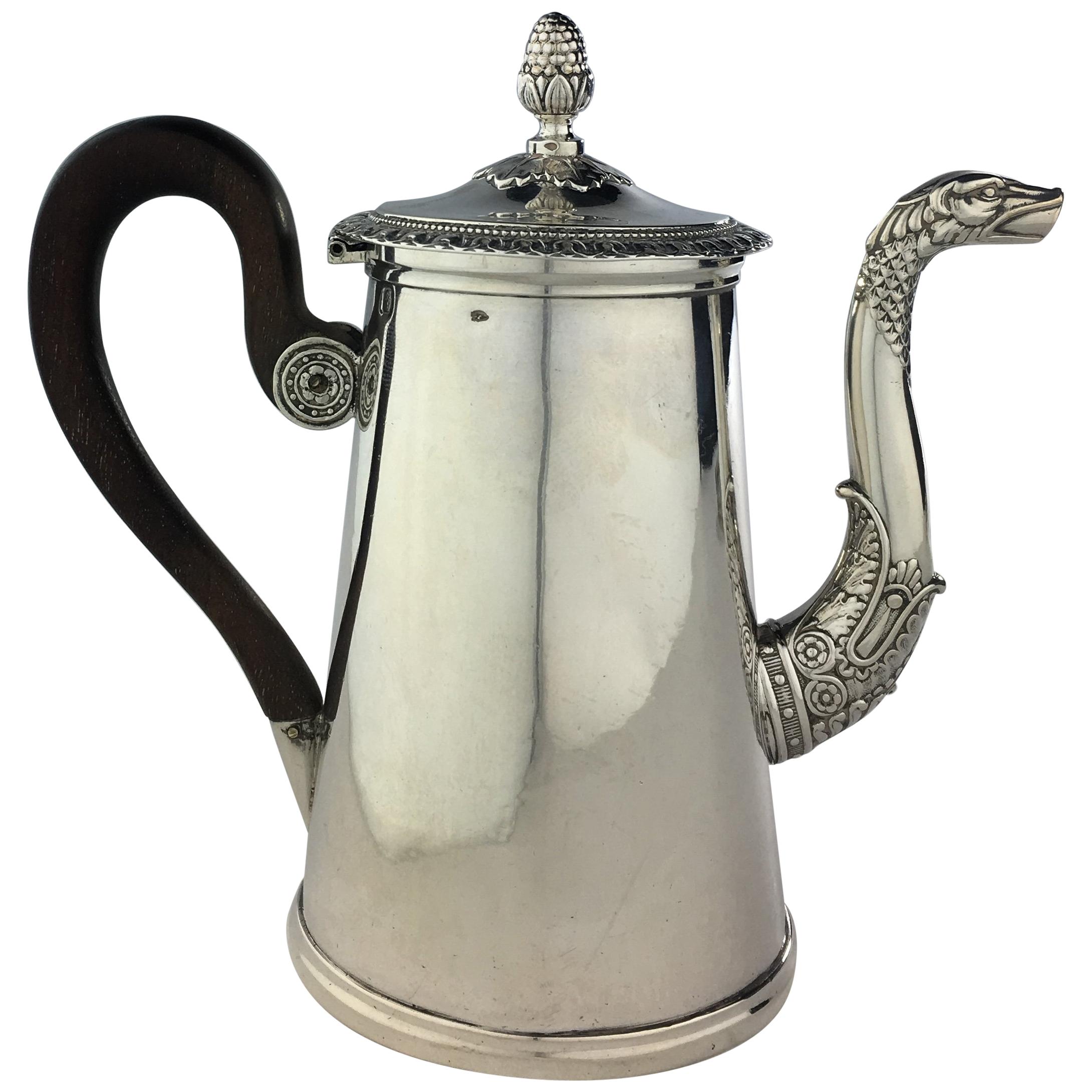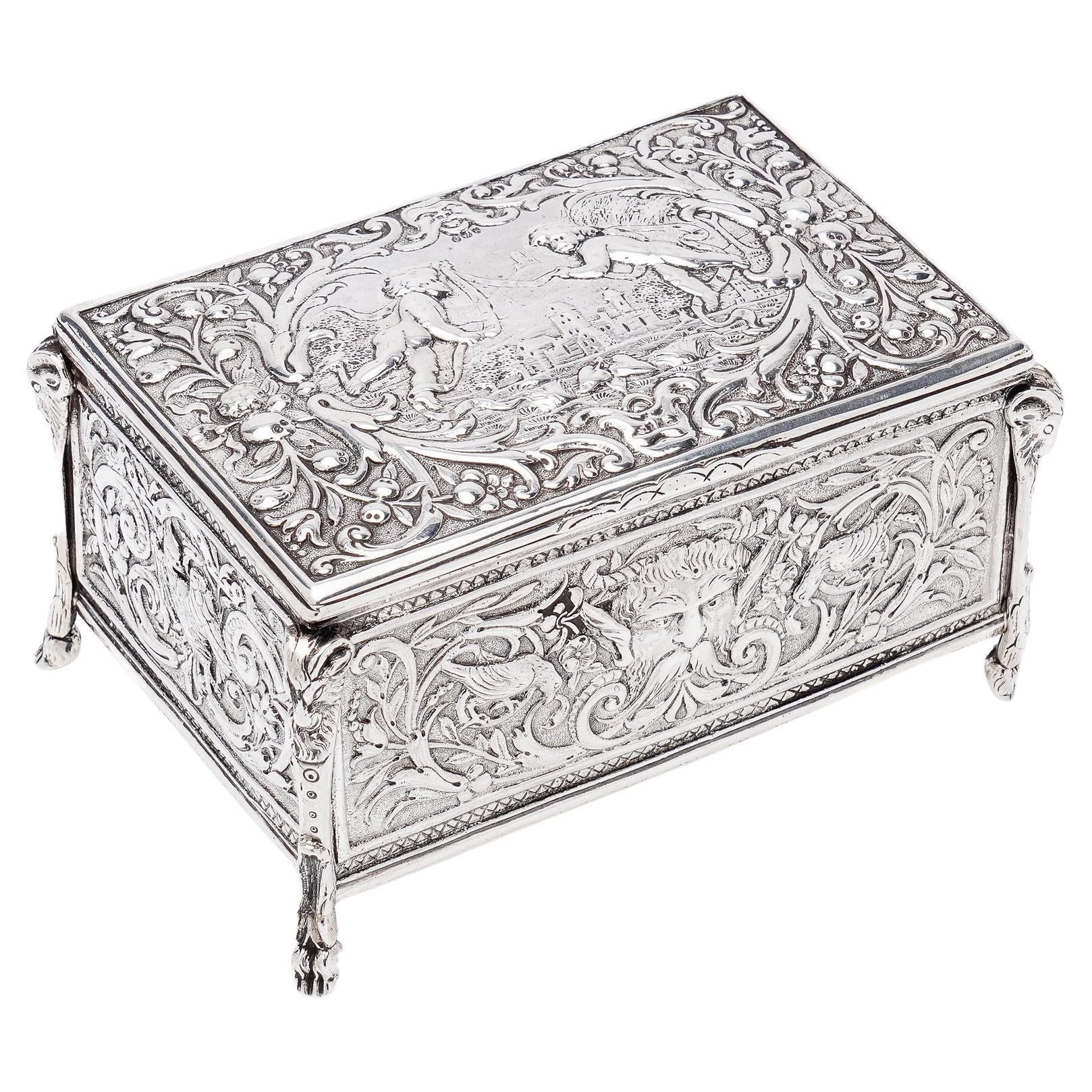Items Similar to Antique Late 19th Century German 930, Silver Rococo Lady's Shoe with Elf Toe
Want more images or videos?
Request additional images or videos from the seller
1 of 12
Antique Late 19th Century German 930, Silver Rococo Lady's Shoe with Elf Toe
About the Item
Antique German 930. silver Rococo Lady's shoe with elf toe
Shoe is with chased scrolls, floral garlands and open bands.
Made in Germany.
Maker: Gebruder Neumann
Imported to England, London, 1896 by William Moering.
Dimensions:
15.5 x 4 x 7 cm
Weight: 118 grams
Condition report: The item is pre - owned, has age related wear and tear, otherwise excellent and pleasant overall condition, please see pictures.
- Creator:Gebruder Neumann (Metalworker)
- Dimensions:Height: 2.76 in (7 cm)Width: 1.58 in (4 cm)Depth: 6.11 in (15.5 cm)
- Materials and Techniques:
- Place of Origin:
- Period:
- Date of Manufacture:circa 1890s
- Condition:
- Seller Location:Braintree, GB
- Reference Number:1stDibs: LU2962323810772
About the Seller
4.6
Vetted Seller
These experienced sellers undergo a comprehensive evaluation by our team of in-house experts.
Established in 2015
1stDibs seller since 2017
90 sales on 1stDibs
Typical response time: 11 hours
- ShippingRetrieving quote...Ships From: Braintree, United Kingdom
- Return PolicyA return for this item may be initiated within 10 days of delivery.
More From This SellerView All
- Antique Late 19th Century Silver Repoussé Decorated Jewellery Box with CherubsLocated in Braintree, GBAntique Late 19th century silver repoussé decorated jewellery box with Cherubs, Forest God in the centre surrounded by the birds and floral motifs . Interior is decorated with gre...Category
Antique 1890s Jewelry Boxes
MaterialsSilver
- Antique German Silver Tea Strainer Decorated with Lady and GentlemanLocated in Braintree, GBAntique silver tea strainer decorated with lady and gentleman, scrolls and flower garlands. Maker: Friedrich Reusswig Made in Germany, 20th Century Import marks: Elly Isaa...Category
Early 20th Century German Edwardian Sterling Silver
MaterialsSilver
- Antique Late 18th Century French Silver BeakerLocated in Braintree, GBAntique late 18th century French silver beaker Made in France, circa 1774-1880 Hallmarked for 950. silver Dimensions- Approximate size: Di...Category
Antique Late 18th Century French Sterling Silver
MaterialsSilver
- Late 19th century French 800. silver and blue enamel belt buckleLocated in Braintree, GBLate 19th century French 800. silver and blue enamel belt buckle. Hallmarked with French boar head mark and French maker's mark. Maker unidentified. The measurements: Length x wid...Category
Antique Late 19th Century French Sterling Silver
MaterialsSilver, Enamel
- Antique 19th Century French 800.S Silver and Hand Painted on Porcelain SealLocated in Braintree, GBAntique 19th century French 800.s silver and hand - painted on porcelain seal stamp is with a family crest, featuring a shield with two eagles standing opposite each other and pineco...Category
Antique Early 19th Century French Sterling Silver
MaterialsSilver
- Antique Late 18th Century Sugar CasterLocated in Braintree, GBAntique Georgian sterling silver sugar caster Made in England, London, 1795 The maker's mark is faded, unidentified. Dimensions: Diameter 6 cm Height 17.5 cm Total weight: 12...Category
Antique 1750s Sterling Silver
MaterialsSilver
You May Also Like
- Antique German Sterling Silver Lady's Shoe with Elf ToeLocated in New York, NYGerman sterling silver lady’s shoe. Imported to England by Theodor Hartman in 1902. Shoe has pointy upturned elf toe and open bands. Exterior decorated wit...Category
Antique Early 1900s German Edwardian Sterling Silver
MaterialsSterling Silver
- Antique 19th Century French Sterling Silver Rococo Chocolate PotLocated in Miami, FLAn elegant 19th century French hallmarked sterling silver chocolate pot with embossed decoration. The pot is decorated with a band around the top. There is embossed decoration on top...Category
Antique 19th Century French Rococo Sterling Silver
MaterialsSterling Silver
- 19th Century German Silver CenterpieceLocated in Palermo, ITElegant embossed centerpiece with four feet lion-shaped paw shape with engravings of letters inside the emblem. German hallmarking system was unified in 1888 (see Decree January 7, 1...Category
Antique Late 19th Century German Victorian Decorative Bowls
MaterialsSilver
- 19th Century German Rococo Revival Repoussé 800 Silver Centerpiece or BowlBy J.D. Schleissner & Söhne 1Located in Philadelphia, PAA large-scale, extremely ornate 19th century Rococo Revival solid silver bowl or centrepiece. Constructed of worked and fused sections each having large cartouches. Each cartouch...Category
Antique Late 19th Century German Rococo Revival Decorative Bowls
MaterialsSilver
- Pair of Antique Silver Grape Shears, Krusius Brothers, Germany Late 19th CenturyLocated in Milan, ITPair of antique grape shears, Krusius Brothers, made of sterling silver with the motif of grapes, grape leaf, vine in three dimensions with fox heads. These shears are made in German...Category
Antique Late 19th Century German Sterling Silver
MaterialsSterling Silver
- 19th Century Italian Sterling Silver Madonna, circa 1830Located in Milano, ITEmbossed and engraved silver plaque La Madonna del lago (The Madonna of the Lake) Probably Milan, post 1824 Brass frame It measures 16.14 in x 13.85 in (41 x 35.2 cm) and it weighs 10.357 pounds (4.698 g): silver 1.31 pounds (598 g) + brass 9.03 pounds (4.100 g) State of conservation: some abrasions on the bottom. The frame is old, but not original. The plaque is made up of a sheet of embossed and engraved silver, and held in a solid brass frame. It depicts the “Madonna del lago” – “Madonna of the Lake” - (the Madonna with Child and San Giovannino) by Marco d'Oggiono (Oggiono, 1474 circa - Milan, 1524 circa), while changing only the background landscape. Almost certainly the subject reproduced in the plaque was taken from a famous engraving by Giuseppe Longhi (Monza, 1766 - Milan, 1831), one of the greatest engravers of his era. The silver is unmarked, probably because originally the Madonna was due to be exposed in a church: sometimes precious metals destined for worship and liturgical use would be exempted from payment and were, therefore, not marked. It is very likely that the plaque was made in Milan because in this city in 1824 the engraving by Giuseppe Longhi was made and printed. In addition, in Milan, the alleged lost painting by Leonardo da Vinci in his Milanese period (1482-1500) would be produced; this is the painting from which Marco d'Oggiono took his version. The painting Marco d?Oggiono was one of Leonardo da Vinci's most brilliant students and collaborators (D. Sedini, Marco d’Oggiono, tradizione e rinnovamento in Lombardia tra Quattrocento e Cinquecento, Roma 1989, pp. 151-153, n. 56; p. 225, n. 124, with previous bibliography). His style reflects in every way that of the Tuscan Maestro, so much so that he was the one who executed some copies of da Vinci's paintings. The execution of the “Madonna del Lago” probably draws inspiration from a lost painting by the Maestro, created while he was living in Milan (1482-1500). There are many similarities with other works by Leonardo such as the “Vergine delle rocce” or the “Vergine con il Bambino e San Giovannino, Sant’Anna e l’Agnello”. The painting, from which the drawing and then the famous engraving were taken, is found today at the M&G Museum of Bob Jones University in Greenville, South Carolina, where it came to rest after the sale of the Harrington Collection in London in 1917. The work appears in the inventories of the collection of Napoleon and Joséphine Bonaparte at the castle of Malmaison, before 1809. The Malmaison building was born and developed in the 17th and 18th centuries. In the 18th century it belonged to Jacques-Jean Le Coulteux du Molay, a wealthy banker. Later, during the Directory, Joséphine Bonaparte de Beauharnais bought it on April 21st, 1799, but settled at the castle definitively only after her husband separated from her in 1809. She remained there until 1814, the year of her death. When Joséphine died, the estate passed to her son Eugène de Beauharnais, who moved to Munich with his whole family in 1815, bringing with him the collection of paintings he inherited from his mother. Eugène died in 1824 and his wife Augusta of Bavaria (von Bayern), unable to keep it, in 1828 sold the Malmaison to the Swedish banker Jonas-Philip Hagerman. It is likely that in this period Augusta also sold part of the paintings inherited from her husband, including the “Madonna del Lago”. This painting then came into the possession of Leicester Stanhope, fifth Earl of Harrington (1784 - 1862) and then was passed down to his descendants. In 1917, at the death of Charles, eighth Earl of Harrington, his brother Dudley inherited the title and properties and he put up a part of his collections for sale. Among these, precisely, the painting by Marco d'Oggiono was to be found. On the occasion of that auction the painting was presented as a work by Cesare da Sesto, by virtue of a handwritten note by the Countess of Harrington on the back of the table. However, already in 1857, the German critic Gustav Waagen had identified Marco d'Oggiono as the author of the painting, then exhibited in the dining room of Harrington House in London (Treasures of Art in Great Britain, in 4 volumes, London, 1854 and 1857). The engraving Giuseppe Longhi was one of the most renowned engravers in Italy between the end of the 18th century and the first quarter of the 19th century. In 1824 Giuseppe Longhi, based on a design by Paolo Caronni, made a famous engraving of the painting of Marco d?Oggiono. The activity of Longhi was then at the peak of his notoriety, enough to earn him very substantial commissions; it is not risky to suppose that some of his successful engravings were also reproduced using other means: in our case in silver. (A. Crespi, a cura di, Giuseppe Longhi 1766–1831 e Raffaello Morghen...Category
Antique 1820s Italian Neoclassical Sterling Silver
MaterialsSterling Silver, Brass
Recently Viewed
View AllMore Ways To Browse
Antique German Sterling Silver
Sterling Garland
Sterling Silver Lady
Antique Silver Shoes
Antique Glass Shoes
Antique Shoe Maker
Elf Antique
Antique German Elf
Elf Shoes
Sterling Gold Set Serveware
Sterling Silver Knife Fork And Spoon Set
Tiffany Glass Patterns
Vintage Acorn
Sterling Silver Tea Spoons
Sterling Tea Spoons
Sterling Gold Wash
Sterling Silver Pie Server
Spoon Silver England





